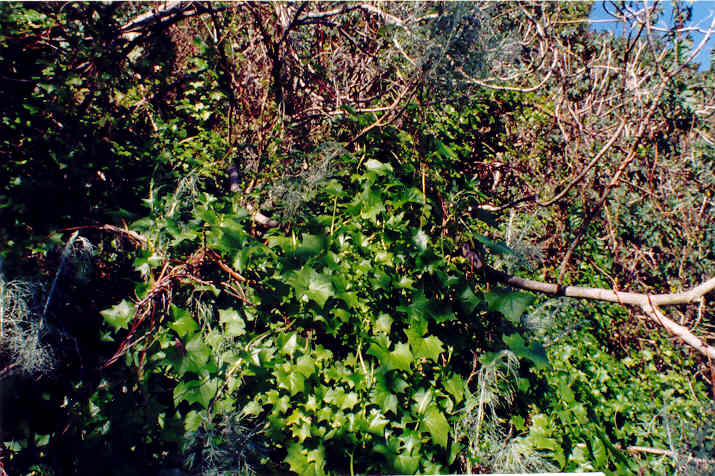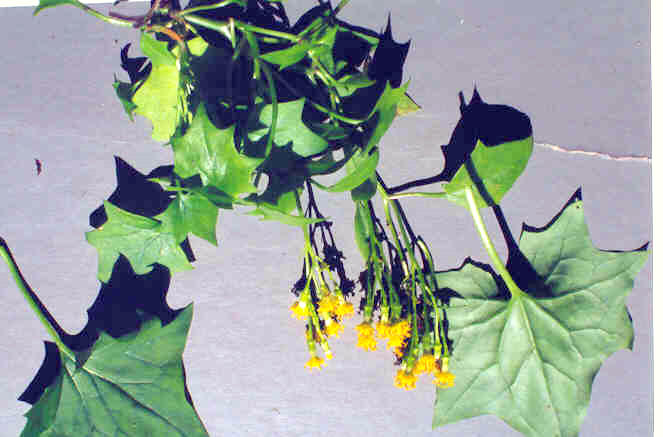 |
=Delairea odorata
South Africa
German Ivy
Cape Ivy
|
February Photo
Plant
Characteristics: Glabrous perennial with slender twining stems to 6 m. long;
lvs. roundish-cordate, sharply 5-7 angled, 2-8 cm. long, ca. as wide; petiole as
long or longer; infl. heads discoid 20-40; pedunculate, axillary toward the
summit of the stems; invol. 3-4 mm. long; principal phyllaries ca. 8, 3-4 mm.,
green tipped; rays 0; disk fls. less than 40, yellow; aks. glabrous.
Habitat:
Shady, +/- disturbed places below 200 m. along coast of s. Calif. and cent. Calif.
Escape from cultivation. Dec.-March.
Name:
Latin, senex, old man, because
of the white pappus.
Mikanioides, Mikania-like. (Bailey
18). Mikania is an American herbaceous or shrubby climber, of about 150
species. (Bailey 1023).
Mikania was named for Joseph
Gottfried Mikan, 1713-1814, professor
at Prague. (Bailey 1023).
Latin, odoratus, sweet-smelling, fragrant. ( Jaeger 171).
I can find no information on the origin of the genus name Delairea. (my
comment). The genus name Delairea
is apparently replacing Senecio according to the below referenced
article. The only species in the
genus. (Sigg, Jacob “Triple
Threat From South Africa” FREMONTIA,
A Journal of the California Native Plant Society Vol. 31 No. 4 October 2003
pp. 21-28).
General:
Rare in the study area, found only in one large colony on the bluff side
between Mariners Dr. and North Star beach.
(my comment)
Senecio is among the largest
genera of flowering plants. Invasive
plant (Hickman, Ed. 336,340).
Evergreen in mildest areas, deciduous elsewhere.
Twines to 18-20 ft. (Sunset
Editors, New Western Garden Book 1984. p.465). Several South African plants pose a threat to the
biodiversity of the California coast. Three
are particularly noxious, Cape Ivy, Delairea odorata; ehrharta, Ehrharta
erecta; and yellow oxalis, Oxalis pes-caprae.
Without tendrils or aerial rootlets to help it climb, Cape Ivy is very
successful in climbing to the tops of large shrubs and trees.
When it has no support from its host for a climbing ladder it will twine
several stems together to move upward, ultimately covering its host plant and
killing it. With a solid mat of
Cape Ivy on the ground, trees and shrubs are unable to reproduce from seed, to
be replaced by a biological wasteland of only Delairea.
Called the kudzu of the west, because it covers other vegetation with
thick growth, cutting off light and air, Delairea odorata, has been in
California for a long time; there is a UC Berkeley herbarium sample dated 1892.
During its tenure in California, Cape Ivy has spread along the coast with
infestations developing much faster than they can be controlled.
Plants spread both sexually through seed and vegetatively from rooting
stems and its growing habits make it difficult to control by chemical or
mechanical means. Listed as an A-1
wild land weed on the California Exotic Pest Plant Council ranking of Invasive
Plants of Greatest Ecological Concern in California.
Biocontrol seems the most likely solution to this weed and
it will be necessary to research how well
predatory insects have controlled Cape Ivy in its native South Africa where it
is an uncommon plant. (Sigg, Jacob “Triple Threat From South Africa”
FREMONTIA, A Journal of the California Native Plant Society Vol.
31 No. 4 October 2003 pp. 21-28).
Text
Ref: Bailey 1019; Hickman Ed.
340; Munz, Flora So. Calif. 226;
Sunset Editors 465.
Photo
Ref: Feb 99 # 2A,4A,5A.
Identity:
by R. De Ruff, confirmed by John Johnson.
First
Found: February 1999.
Computer
Ref: Plant Data 511.
Have
plant specimen.
Last
edit 5/31/04.
February Photo


